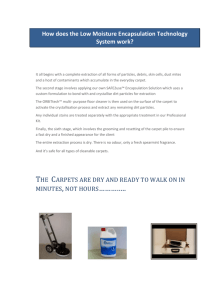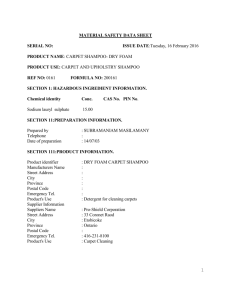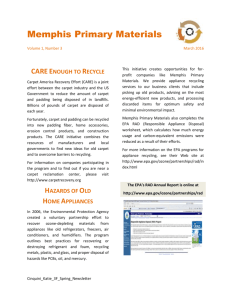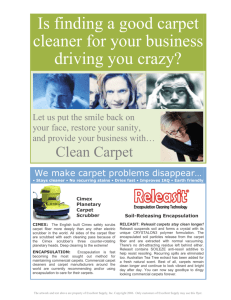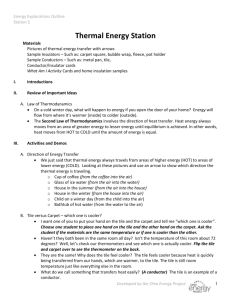Section 09681 - Modular Carpet Tile
advertisement
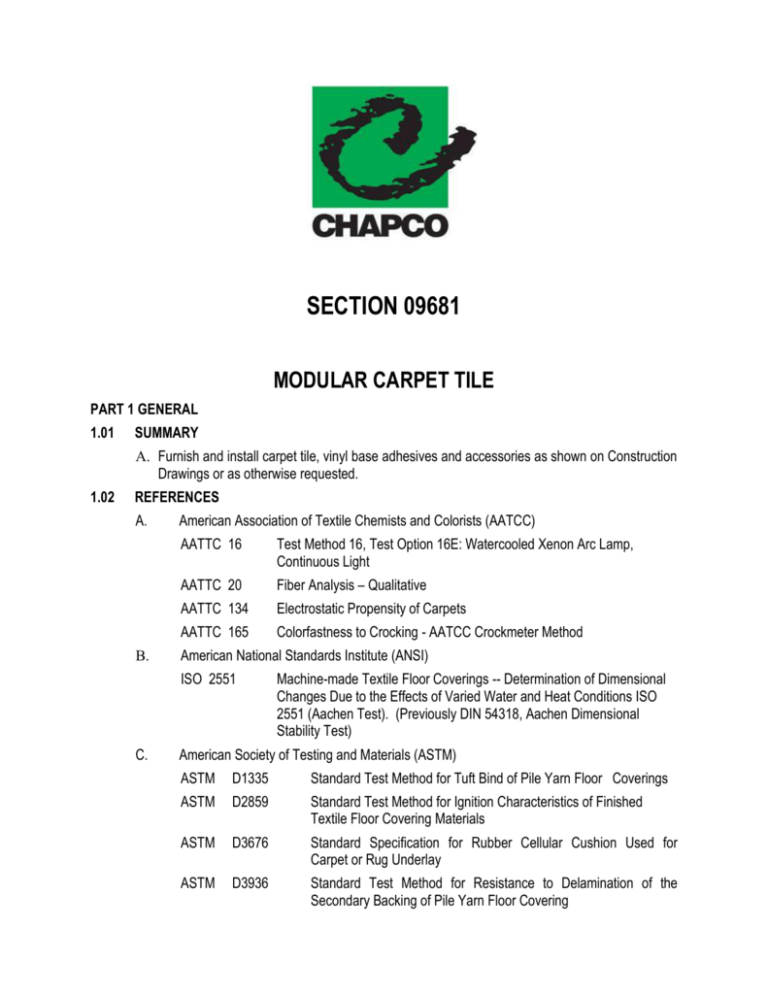
SECTION 09681 MODULAR CARPET TILE PART 1 GENERAL 1.01 SUMMARY A. Furnish and install carpet tile, vinyl base adhesives and accessories as shown on Construction Drawings or as otherwise requested. 1.02 REFERENCES A. B. American Association of Textile Chemists and Colorists (AATCC) AATTC 16 Test Method 16, Test Option 16E: Watercooled Xenon Arc Lamp, Continuous Light AATTC 20 Fiber Analysis – Qualitative AATTC 134 Electrostatic Propensity of Carpets AATTC 165 Colorfastness to Crocking - AATCC Crockmeter Method American National Standards Institute (ANSI) ISO 2551 C. Machine-made Textile Floor Coverings -- Determination of Dimensional Changes Due to the Effects of Varied Water and Heat Conditions ISO 2551 (Aachen Test). (Previously DIN 54318, Aachen Dimensional Stability Test) American Society of Testing and Materials (ASTM) ASTM D1335 Standard Test Method for Tuft Bind of Pile Yarn Floor Coverings ASTM D2859 Standard Test Method for Ignition Characteristics of Finished Textile Floor Covering Materials ASTM D3676 Standard Specification for Rubber Cellular Cushion Used for Carpet or Rug Underlay ASTM D3936 Standard Test Method for Resistance to Delamination of the Secondary Backing of Pile Yarn Floor Covering D. ASTM D5116 Standard Guide for Small-Scale Environmental Chamber Determinations of Organic Emissions from Indoor Materials/Products ASTM D5252 Standard Practice for the Operation of the Hexapod Drum Tester ASTM D5417 Standard Practice for the Operation of the Vetterman Drum Tester ASTM E648 Standard Test Method for Critical Radiant Flux of Floor-Covering Systems Using a Radiant Heat Energy Source ASTM E662 Standard Test Method for Specific Optical Density of Smoke Generated by Solid Materials Carpet and Rug Institute (CRI) CRI E. Indoor Air Quality Testing Program CRI TM101 Assessment of Carpet Surface Appearance Change CRI TM102 Fluorochemical Finishes CRI 104 Consumer Product Safety Commission (CPSC) CPSC F. 1.03 Standard for Installation of Commercial Carpet FF-1-70 Methenamine Pill Test National Fire Protection Association (NFPA) NFPA 101 Life Safety NFPA 253 Standard Method of Test for Critical Radiant Flux of Floor Covering Systems using a Radiant Heat Energy Source SUBMITTALS A. The following shall be submitted in accordance with Section 01330, “Submittal Procedures": B. Product Data: Submit manufacturer's product literature and installation instructions for each type of carpeting material and installation accessory required. C. Samples: D. 1. Submit manufacturer's standard size samples showing full range of colors, textures and patterns available for each type of carpet tile required. 2. Submit a minimum of four 18-inch square samples for each type of carpet tile required. Submit samples that are large enough to show pattern repeat if beyond an 18-inch sample dimension. 3. Submit samples of each type exposed edge stripping, vinyl base, and accessory item. Certification: 1. Submit certificate stating that the manufacturer and installer comply with Quality Assurance requirements. Include a minimum of five (5) references, complete with addresses, telephone numbers and contact persons for installations within the time period indicated. 2. Submit manufacturer's certificate stating that materials furnished comply with specified requirements. Include supporting independent certified laboratory testing data indicating that material meets specified test requirements. 3. Submit Material Safety Data Sheet (MSDS) for adhesives, leveling compounds, and primers required. 4. E. Submit written warranty information stating compliance with requirements. Sustainability: 1. Submit manufacturer's documentation of recycled content for each product. 2. Submit documentation of manufacturer's buyback and/or recycling program. 3. Submit manufacturer's documentation that carpet, cushion and adhesives meet the Carpet and Rug Institutes (CRI) Indoor Air Quality (IAQ) Testing Programs Green Label or comply with the following total volatile organic compounds (VOC) emissions criteria: a. b. c. F. 1.04 1.05 1.06 Carpet not to exceed 0.5 milligrams per square meter per hour Cushion not to exceed 1.0 milligrams per square meter per hour Adhesive not to exceed 10.0 milligrams per square meter per hour Maintenance Instructions: Submit manufacturer's printed instructions for maintenance of installed work, including methods and frequency recommended for maintaining optimum condition under anticipated traffic and use conditions. Include precautions against materials and methods which may be detrimental to finishes and performance. QUALITY ASSURANCE A. Manufacturer Qualifications: Firm (material producer) with not less than 5 years of production experience, who’s published literature, clearly indicates general compliance of products with requirements of this section. B. Installer Qualifications: Firm with not less than 5 years of experience in installation of commercial carpet tile of type, quantity and installation methods similar to work of this section. C. Labeling: A label meeting the Federal Labeling Requirements, as stated in the Textile Products Identification Act under the Federal Trade Commission, shall be attached to the certification samples and the products delivered. D. For each colorway, per floor, furnish carpet tile from one dye lot only. DELIVERY, STORAGE, AND HANDLING A. Comply with CRI 104, Section 5, “Storage and Handling.” B. Deliver materials to site in original factory wrappings and containers, clearly labeled with identification of manufacturer, brand name, quality or grade, fire hazard classification, and lot number or provide independent certificates. C. Store materials in original undamaged packages and containers, inside well-ventilated area protected from weather, moisture, soiling, extreme temperatures, humidity; laid flat, blocked off ground to prevent sagging and warping. Maintain temperature in storage area above 40 degrees F. Do not stack packages higher than recommended by manufacturer. D. Comply with instructions and recommendations of manufacturer for special delivery, storage, and handling requirements. E. Extra Materials: On projects over 100 square yards, furnish an additional 2 percent of carpet to be stored on SNL site for maintenance/replacement needs. Additional carpet shall be packaged for storage to prevent damage from sagging, warping, and other deleterious effects. SEQUENCING AND SCHEDULING A. Coordinate work of this section with other work to ensure that installed carpeting materials are not damaged or soiled. 1.07 1.08 PROJECT CONDITIONS A. General: Comply with CRI 104, Section 6.1, “Site Conditions; Temperature and Humidity.” B. Environmental Limitations: Do not install carpet tile until wet work in spaces is complete and dry, and ambient temperature and humidity conditions are maintained at the levels indicated for project when occupied for its intended use. C. Do not install carpet tile over concrete slabs until slabs have cured and are sufficiently dry to bond with adhesive and concrete slabs have pH range recommended by carpet tile manufacturer and in compliance with the values outlined in 3.01A of this document. Refer to section 9699 for requirements for slabs and substrates with elevated vapor emission, RH, and pH levels. D. When demountable partitions or other items are indicated for installation on top of carpet tile, install carpet tile before the installation of these items. WARRANTY A. Warranties shall cover all labor and materials, including labor and installation costs involved to replace defective product and workmanship. All warranty items are full term, not pro-rated. B. General Installation Material Warranty: Provide single source installation product warranty covering moisture mitigation (if needed or required), surface preparation products (Section 3540), and appropriate adhesive product for flooring specified. All products to be sourced from a single manufacturer providing a system warranty of not less than 10 years. C. Special Carpet Tile Warranty: Written warranty, signed by carpet tile manufacturer agreeing to replace carpet tile that does not comply with requirements or that fails within specified warranty period. Failures include, but are not limited to, more than 10 percent loss of face fiber, edge raveling, snags, runs, and delamination. 1. D. Warranty Period: minimum, non-prorated years, from date of construction complete. Special Installation Warranty: Written warranty, signed by carpet tile installer and general contractor agreeing to correct faulty workmanship. 1. Installation Warranty Period: 2 years from date of construction complete. PART 2 – PRODUCTS 2.01 MANUFACTURERS A. Subject to compliance with requirements, manufacturers offering products that may be incorporated in the work include, but are not limited to, those listed below. 1. Lees Commercial Carpets Division/BurlingtonIndustries, Inc. (www.leescarpets.com) 2. Mannington Mills Inc. (www.mannington.com) 3. Milliken Contract Carpets (www.milliken.com) 4. Shaw Contract Group (www.shawcontract.com) 5. Collins & Aikman Floorcoverings, Inc. (www.powerbond.com) 6. Interface Company (www.interfaceinc.com) 7. Beaulieu of America Carpets (www.beaulieu-usa.com) 8. Bentley Prince Street (www.bentleyprincestreet.com) 9. Mohawk Flooring (www.mohawkflooring.com) 10. 2.02 J+J/Invision Commercial Carpets (www.jj-invision.com) INSTALLATION MATERIALS A. Compatibility: Provide single source carpet, adhesives, and other related materials that are compatible as a system and with substrates under conditions of service and application. 1. CHAPCO Safe-Set 2 Releasable Pressure Sensitive Adhesive. Install as recommended by CHAPCO / H.B. Fuller Construction Products Inc. www.chapco-adhesive.com. CHAPCO Safe-Set 2 Releasable Pressure Sensitive Adhesive will tolerate MVER levels of up to 10 lbs or RH readings up to 90% in new concrete slabs. 2. Appearance Retention Rating: Severe (short-term not less than 4.0, long-term not less than 3.5) based on ASTM D-5252 (Hexapod) using 3750-gram tumbler or ASTM D-5417 (Vettermann) test method. Carpets shall be tested without underlay. The exposure conditioned carpet shall be assessed according to CRI TM-101. 3. Tuft bind: minimum average value, 8.0 pounds (Loop Pile) 4. Dimensional Stability: maximum dimensional change ± 0.2 percent 5. Delamination Resistance of the Secondary Backing: not less than 2.5 pounds per inch 6. Colorfastness (entire colorline): a. b. To Crocking: Color transfer Class 4 minimum, wet and dry, when tested as specified To light: Color contrast between the exposed and unexposed carpet areas equivalent to a minimum of Grade 4 on the Gray Scale for Color Change after an exposure to 60 AFU (AATCC fading units) for all colors 7. Fluorochemical finish: minimum average of 350 parts-per-million fluorine on the pile fiber when tested in accordance with CRI TM-102. 8. Antimicrobial Activity: Inherently antimicrobial, topical finishes not allowed. 9. Electrostatic Propensity: maximum 3.5 kV 10. Flammability: a. b. c. 11. Methenamine Pill Test: Self Extinguishing – compliance with Federal Flammability Standards CPSC FF-1-70 when tested in accordance with ASTM D 2859. Radiant Panel: minimum critical radiant flux of 0.45 watts per square centimeter. Smoke Density: maximum 450 Indoor Air Quality: a. b. c. Carpet: shall be only those certified with the CRI IAQ Carpet Testing Program Green Label, or tested for compliance to meet the CRI IAQ Carpet Testing Program requirements and criteria. Adhesive: shall be only those certified with the CRI IAQ Adhesive Testing Program Green Label or tested for compliance to meet the CRI IAQ Adhesive Testing Program requirements and criteria. All products (carpet, cushion and adhesives) from current production must be retested on a quarterly basis to ensure continuing compliance with CRI IAQ Test Program requirements. C. Material Requirements: 1. Pile Fiber Type: 100 percent continuous filament nylon, Type 6 or Type 6,6 2. Backing Materials: a. b. 3. 4. D. Recycled Content: Renewed nylon carpet, which is cleaned, retextured, recolored, or otherwise reused to produce new nylon carpet is acceptable; otherwise comply with the following recycled content requirements: 2.04 a. Nylon Carpet Face Fiber: 25 percent minimum total recovered materials content. b. Nylon Carpet Backing: For vinyl primary backing, use the highest percentage of total recovered materials content available; however 0% is not acceptable. c. Polymeric Cushion: Preference will be given to recycled content cushion backings. All materials must be 100% recyclable Construction Requirements 1. Surface texture: level or textured loop, multi-level loop, or pattern 2. Yarn: Multi-ply 3. Tufting Machine Gauge: minimum 1/10 gauge 4. Number of Stitches: minimum 8 per inch Finished pile thickness: minimum 0.125 inch, maximum 0.5 inch 5. 2.03 Primary Backing: 100 percent synthetic materials. Secondary Backing: Fiberglass reinforced secondary backing consisting of a polymeric cushion or hard back compound consistent with all performance testing requirements. 6. Average Finished Pile Yarn Weight: minimum 20 ounces per square yard 7. Dye method: Yarn or solution dyed 8. Color: To be selected by the Architect or SDR from Vendor colorline of product meeting this specification MANUFACTURED UNITS A. Product shall have a lead-time of not more than six (6) weeks from the time the dealer receives the order to the time SNL receives the product. B. Patterns and colorways shall be available for a minimum of ten (10) years. C. All products within the same floor of a project shall be from the same dye lot. ACCESSORIES A. Carpet Edge Guard, Nonmetallic: Extruded or molded heavy-duty vinyl or rubber carpet edge guard of size and profile required with minimum 2-inch wide anchorage flange; colors compatible with carpet furnished. B. Surface Skim Coat: CHAPCO SmoothFinish Skim Coat. Install as recommended by CHAPCO/H.B. Fuller Construction Products Inc. www.chapco-adhesive.com. 2.05 C. Vinyl Base: 4 inches high, coved, 0.080 inch gauge: CHAPCO Safe-Set 4 or CHAPCO Safe-Set 400-White Premium Cove Base Adhesive. Install as recommended by CHAPCO/H.B. Fuller Construction Products Inc. www.chapco-adhesive.com. D. Miscellaneous Materials: As recommended by manufacturers of carpet and other carpeting products for intended application. E. Releasable Adhesive for Carpet: CHAPCO Safe-Set 2 Releasable Pressure Sensitive Adhesive. Provide water-resistant, 0 VOC, non-staining, carpet adhesive which complies with flame spread rating required for carpet installation. Install as recommended by CHAPCO/H.B. Fuller Construction Products Inc. www.chapco-adhesive.com. E. Concrete Sealer: Provide concrete sealer compatible with carpet backing material and adhesive. SOURCE QUALITY CONTROL A. Flammability Tests 1. Radiant Panel: ASTM E648, Class I 2. Smoke Density: ASTM E662 3. Methenamine Pill Test: Self Extinguishing (CPSC FF-1-70 or ASTM D 2859). B. Lightfastness: AATCC 16E C. Crocking: AATCC 165 D. Static Electricity: AATCC 134 E. Dimensional Stability: ISO 2551 F. Turf Bind: ASTM D1335 G. Delamination Resistance: ASTM D3936 H. Fluorochemical Finish: CRI TM-102 I. Electrostatic Propensity: AATCC 134 J. Indoor Air Quality: ASTM D5116 K. Pile Fiber Identity: AATCC 20 L. Backing Material Identity: AATCC 20 M. Attached Backing: 1. Thickness: ASTM D3676 2. Volume Density: ASTM D3676 3. Compression Resistance: ASTM D3676 4. Compression Set: ASTM D3676 N. Test in accordance with NFPA 253 (ASTM E-648) when applying the floor finish requirements of the Life Safety Code (NFPA 101) to DOE Facilities. O. Carpets and rugs should have a critical radiant flux not less than the following: 1. 0.45 watts per square centimeter in areas unprotected by an automatic fire suppression system; and 2. 0.22 watts per square centimeter in areas protected by an automatic fire suppression system. PART 3 - EXECUTION 3.01 EXAMINATION A. Examine substrates for moisture content alkaline presence and other conditions under which carpet tile is to be installed. Provide Calcium Chloride test results to verify amount of moisture in new or existing slabs. Calcium Chloride shall be less than or equal to ten (10) pounds per one thousand (1000) square feet in 24 hours when using CHAPCO SafeSet 2 Releasable Pressure Sensitive Adhesive. Alkalinity testing shall result in a pH range of 5–9. Notify GC in writing of conditions detrimental to proper completion of the work. Do not proceed until unsatisfactory conditions have been corrected. See section 9699. 1. 3.02 CHAPCO DEFENDER Moisture Vapor Barrier. Install as recommended by CHAPCO/H.B. Fuller Construction Products Inc. www.chapco-adhesive.com. B. Field verifies all dimensions and other work conditions affecting the installation of carpet tile. C. The carpet covered by this specification is intended for end use applications that have a Severe Use Classification. It is the Contractor’s responsibility to provide only products compatible with adjacent materials in the assembly. PREPARATION A. General: Comply with CRI 104, Section 6.2, “Site Conditions; Floor Preparation,” and carpet tile and installation system manufacturer’s written installation instructions for preparing substrates indicated to receive carpet tile installation. 1. Concrete shall be cured, clean and dry before installation proceeds. 2. Repair minor holes, cracks, depressions or rough areas using floor patching/leveling compound that is compatible with the adhesive to be used. Protrusions over 1/32 inch shall be leveled. Large patched areas shall be primed. 3. Whenever a powdery or porous surface is encountered, Scrub with a solution of white vinegar & water at a ratio of 1:1 and rinse with clean water. Install primer compatible with the adhesive. Primer shall be used to provide a suitable surface for glue-down installation. a. CHAPCO Multipurpose Primer. Install as recommended by CHAPCO/H.B. Fuller Construction Products Inc. www.chapco-adhesive.com. 4. Remove existing brass utility caps and install grout to fill caps; Grout level with existing substrate. 5. Remove grease, oils, loose particles, paint, dirt, curing and parting agents, and all other foreign substances. Clear away debris and scrape up cementitious deposits from surfaces to receive carpet tile; vacuum clean immediately before installation. 6. Subfloor shall be level and smooth and free from scaling and irregularities per Carpet and Rug Institute acceptable standards (CRI 104). 7. Coordinate carpet installation with any underfloor electrical/telephone/data so conductors and cables are pulled prior to carpet installation. Accessories (floor power/communications monuments) shall be installed on top of carpet after installation. 8. Sequence carpet tile installation with other work to minimize possibility of damage and soiling of carpet during remainder of construction period. 9. A. Maintain room temperature at minimum 65 degrees F for at least 24 hours prior to installation and relative humidity at approximately that at which the area is to be maintained. Concrete (No Previous Flooring Material): Apply a concrete sealer coat at the rate recommended by the sealer manufacturer. Use thin, fast drying primers that are compatible with adhesives. Apply adhesive only after primer is completely dry. 1. B. CHAPCO Multipurpose Primer. Install as recommended by CHAPCO/H.B. Fuller Construction Products Inc. www.chapco-adhesive.com. Concrete (Previous Flooring Materials Removed): Remove existing adhesive by grinding with a concrete grinding machine and moist sand. Do not use solvents to remove adhesive. Apply concrete sealer at rate recommended by the sealer manufacturer. Use thin, fast drying primers that are compatible with adhesives. Completely cover area with cutback neutralizer per manufacturer's recommendations. 1. C. D. E. 3.03 CHAPCO Multipurpose Primer. Install as recommended by CHAPCO/H.B. Fuller Construction Products Inc. www.chapco-adhesive.com. Wood: Patch all surface irregularities and seal with wood sealer as recommended by manufacturer. 1. CHAPCO Multipurpose Primer. Install as recommended by CHAPCO/H.B. Fuller Construction Products Inc. www.chapco-adhesive.com. 2. CHAPCO SmoothFinish Skim Coat. Install as recommended by CHAPCO/H.B. Fuller Construction Products Inc. www.chapco-adhesive.com. Vinyl Tile: Replace all loose, missing, and broken tiles with tiles of equal thickness making note of any special requirements with respect to asbestos on the Jobsite Hazard Evaluation. Strip existing tile of wax, dirt and other foreign substances. Completely cover area with cutback neutralizer per manufacturer's recommendations and apply embossing leveler. 1. CHAPCO SmoothFinish Skim Coat. Install as recommended by CHAPCO/H.B. Fuller Construction Products Inc. www.chapco-adhesive.com. 2. CHAPCO ADDITIVE Patch Additive. Install as recommended by CHAPCO/H.B. Fuller Construction Products Inc. www.chapco-adhesive.com. Proceed with installation only after unsatisfactory conditions have been corrected. INSTALLATION A. General: Comply with CRI 104, Section 13, “Carpet Modules (Tiles),” and carpet tile manufacturer’s written instructions, except where more stringent requirements are shown or specified, and except where project conditions require extra precautions or provisions to ensure satisfactory performance of the work. 1. Field verifies all dimensions and other work conditions affecting the installation of carpet tile. 2. Unless otherwise noted or approved on drawings, begin laying tile at centerline 3. Comply with carpet tile instructions for direction of carpet tile. Unless otherwise noted on drawings align pattern and pile in the same direction, parallel to the centerline of the area or room 4. Extend carpet tile under open-bottomed obstructions and under removable flanges and furnishings, and into alcoves and closets of each space. Existing systems furniture shall be raised or removed to accommodate continuous carpet installation. B. 5. Provide cut-out where required, and bind cut edges where not concealed by protective edge guards or overlapping flanges. 6. Install carpet edge guard where edge of carpet is exposed; anchor guards to substrate. Use full-length strips only. 7. Expansion Joints: Do not bridge building expansion joints with carpet tile; provide for movement. 8. Carpet tile shall be free from movement when subjected to traffic. 9. Do not use pieces smaller than 1/3 of a standard tile without prior approval by the SDR. 10. Provide mockup for approval by SDR of special cuts/effects such as mitered corners at borders or graphic patters that are prepared and installed onsite. 11. Where there are floor finish material changes at doors, place centerline of abutting materials below door. Glue Down Installation 1. Fit sections of carpet tile into each space prior to application of adhesive. Trim edges. 2. Apply a full spread of adhesive uniformly to substrate in accordance with manufacturer's instructions. Follow MSDS instructions for ventilation requirements. Butt carpet tile edges tightly together to form seams without gaps. Butt edges tightly to vertical surfaces. Eliminate air pockets and ensure uniform bond. Remove adhesive promptly from face of carpet tiles. C. Self-adhesive installation: Install per manufacturer’s recommendation. D. Miscellaneous Installation, Stairway Carpeting: Install per manufacturer's recommendation. Provide vinyl nosing at each riser. Match adjoining carpet installation. E. Install vinyl base after completion of carpet work. Use adhesive as part of a single source system from a single manufacturer. 1. F. 3.04 CHAPCO Safe-Set 4 or CHAPCO Safe-Set 400-White Premium Cove Base Adhesive. Install as recommended by CHAPCO/H.B. Fuller Construction Products Inc. www.chapco-adhesive.com. Coordinate adhesive blocking areas with GC when floating carpet tile over access flooring. CLEANING AND PROTECTION A. Remove and dispose of debris and recycle all unusable scraps. B. Remove excess adhesive and other surface blemishes using cleaner recommended by carpet tile manufacturer. Replace carpet tile where blemishes cannot be removed. Trim protruding face yarn from carpet tile surface. Vacuum carpet tile using commercial quality vacuum cleaner with face-beater element. C. Protect installed carpet tile to comply with CRI 104, Section 15, “Protection of Indoor Installations.” D. Protect installation with a heavy, non-staining building paper. Do not use a moisture barrier such as plastic film. Maintain protection intact until construction complete. E. Advise SDR of protection methods and materials necessary to prevent deterioration or damage until construction complete. 3.05 CARPET REMOVAL A. All carpet tile and scraps removed from project shall be recycled or reapplied. Disposal of product in landfill is not permitted. B. Vacuum in-place carpet with industrial vacuum prior to demolition or debris-producing renovation. C. Remove carpet. D. Stack on pallets for handling. E. Store carpet off ground and under cover to prevent contamination of materials by water, foreign matter or other causes. F. Coordinate with Inspector to deliver removed carpet to recycling program or contact manufacturer for pick-up for recycle. In the case that the manufacturer does not have a recycling program, contact an independent recycling program such as: 1. 2. 3. 4. 5. BASF 6ix Again: (800 839-3233) or www.basf.com Collins & Aikman floor carpet buyback program: (800)248-2878 or www.powerbond.com Dupont-Partnership for Reclamation: (800)328-7719 or www.dupontcommercial.com Honeywell/Evergreen Nylon Recycling: (804)520-3564 or www.n6recycling.com Shaw Inc./Inforum: (877)502-7429 or www.shawcontract.com END OF SECTION

